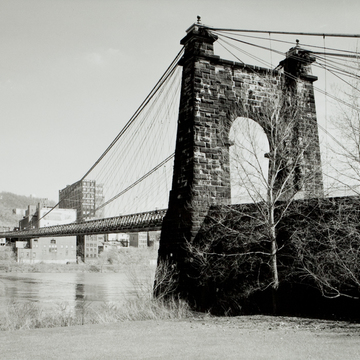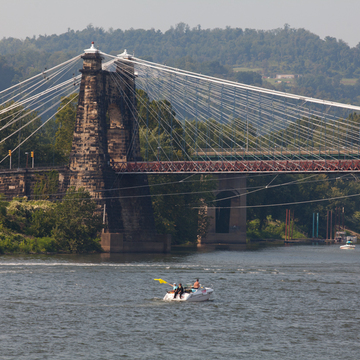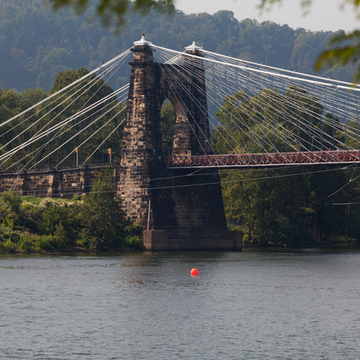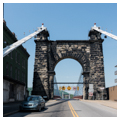Wheeling's best-loved, and arguably its most important, landmark stands strong and sturdy after a century and a half of increasingly heavy use. Built to carry the National Road over the main channel of the Ohio River, the bridge was completed in 1849. It was the first bridge across the Ohio and was—for a time—the longest suspension span in the world, with a clearance of 1,010 feet between its sandstone towers. The bridge lost the “world's longest” title in 1866, when John Roebling's Cincinnati Suspension Bridge was completed, but it remains the nation's oldest major suspension bridge. It was declared a National Historic Civil Engineering Landmark in 1969, and in 1975 the secretary of the interior designated it a National Historic Landmark.
In 1836 the Committee on Roads and Canals of the U.S. House of Representatives requested Charles Ellet, Jr., one of the nation's most prominent civil engineers, to determine the feasibility of constructing a bridge across the river at Wheeling. Ellet reported that it could be done, but then as now, congressional appropriation did not necessarily follow on the heels of congressional inquiry. In 1837, when a covered wooden bridge was built to carry the National Road across the river's narrow back channel, pressure mounted for a longer companion across the main, or east, channel, where crossing still depended on a ferry. Finally, in 1847, stock was subscribed, and plans were solicited. John A. Roebling, who later designed the Brooklyn Bridge and who, along with Ellet, was one of the few engineers in America with experience in the field, proposed a 600-foot span with piers in the river bed, which would narrow the channel for navigation. Ellet, who composed a forty-three-page pamphlet explaining his more daring proposal, envisioned a clear span of 1,010 feet with piers on the riverbanks rather than in the bed, thus keeping the full width of the main channel open to navigation. Ellet acknowledged that a suspension bridge of such length had never been built but claimed it was feasible because “laws governing its equilibrium were known and could be measured accurately.”
Ellet's design called for the mainland tower to rise 153½ feet and the island tower 132¾ feet. The roadway would thus be on a slope, descending from the higher mainland to the lower-lying island. Ellet made another astute calculation—a political one this time—by specifying, “the cables and all the iron work will be manufactured at Wheeling, of the best material that the country affords.” By a vote of seven to one, the board of directors endorsed his proposal over Roebling's, and construction began in the summer of 1848. To augment the local work force, additional laborers—among them stonemasons, cutters, riggers, carpenters, and quarry hands—were induced to come from Baltimore. They were induced to stay by the requirement that they pay their own return-trip expenses if they decided to remain in Wheeling for fewer than six months.
Not surprisingly, Pittsburgh objected to the bridge, arguing that it would impede river navigation because large steamboats would not be able to pass beneath the roadway. In August 1849, the Commonwealth of Pennsylvania filed a suit opposing the bridge, and in December the case was presented to the U.S. Supreme Court, which referred it to a special commissioner. During the interim, the bridge was completed. In late October 1849, Ellet drove across in a carriage, and a cannon salute heralded his safe arrival on the island shore. When the bridge was formally opened on November 15, 1849, the Daily Wheeling Gazette reported that the firing of cannon “continued for a great
Thirteen months later, the Supreme Court's commissioner decreed that the bridge was indeed an obstruction to navigation, as Pennsylvania had claimed. In December 1851, the court agreed. Ultimately the decision was reversed, thanks to Chief Justice Roger Brooke Taney, who argued that, inasmuch as the bridge lay entirely within Virginia's territory, the court had no jurisdiction over it. Congress also took a stand in favor of the bridge by requiring steamboats with tall stacks to have them hinged. As the boats passed under the bridge on their way to and from Pittsburgh, they were forced to lower their stacks, almost in the manner of saluting, or bowing, to Wheeling.
The enthusiasm that had attended opening day was cruelly dashed when the cables and roadway collapsed during a storm on May 17, 1854. The local press reported the disaster in doleful, lugubrious language: “With feelings of unutterable sorrow, we announce that the noble and world-renowned structure, the Wheeling Suspension Bridge, has been swept from its strongholds by a terrific storm, and now lies a mass of ruins.” Wheeling was disconsolate. Pittsburgh was jubilant. Pennsylvania attempted to prevent the rebuilding and promptly secured a restraining order. The bridge company just as promptly ignored it. Under Ellet's direction, repairs were made, though the roadway was temporarily narrowed, and the bridge was reopened in January 1856. Adding insult to injury during the period of rebuilding, Pittsburgh steamers regularly lowered their stacks in derision when passing between the wireless abutments, tooting their whistles for all of Wheeling to hear.
In 1859–1860 supervising engineer William K. McComas, who had worked under Ellet's direction when the bridge was repaired, made additional refinements and restored the roadway to its original width. In 1871–1872 cables and sidewalks were reconfigured following designs by John Roebling's son, Washington A. Roebling. Additional repairs have been made over the years, including replacing the wooden flooring with a steel-grated surface. The bridge continues to carry local traffic to Wheeling Island, but it has been superseded as a primary carrier of traffic across the Ohio by the Fort Henry Bridge, which carries Interstate 70 just to its north. In addition to continuing the function for which it was designed and built, the Wheeling Suspension Bridge stands as a tribute to American engineering expertise and to the unbounded enthusiasm and support of Wheeling's citizens in ensuring their city's progress.












